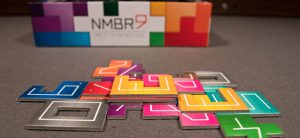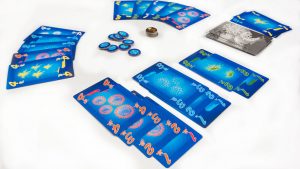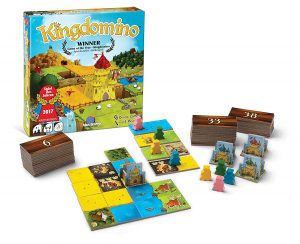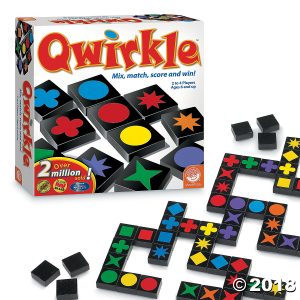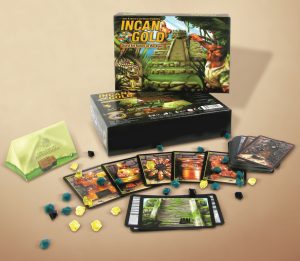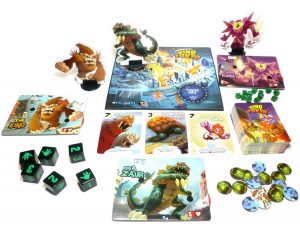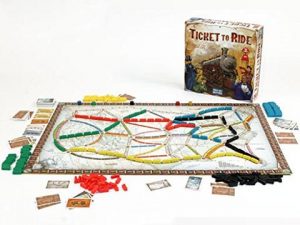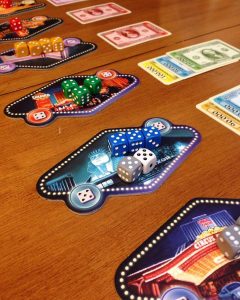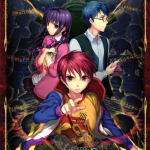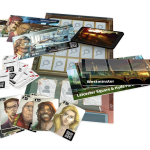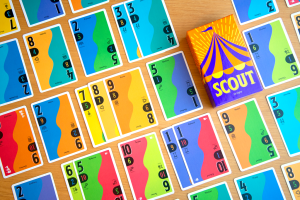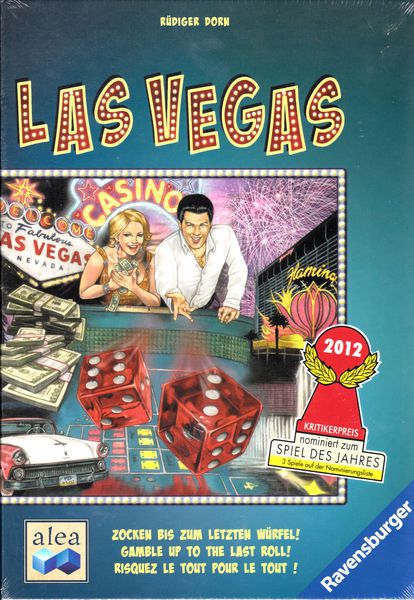
In the words of James Brown, these are family games where you can ‘Teach(hit) it and quit.’ In other words, give the rules explaination in 10 mins or less and walk away in FULL confidence the table has it and they will make no rules mistakes. I wish, but we’ll do our best to get as close as possible. They also need to have a modicum of strategy/tactics involved and be ideally around 30-40 minutes. These are the type of games you want use to introduce people who are new to gaming without blowing their mind.
Now a bunch of you will think, ‘This game should be on the list!’ Before you comment though, think have you actually ever taught it and left them to their own devices, or are you at the table to guide them. We have a lot of experience of doing this and its the mark of a truly great game that can be fun and so simple it can be played by 4 novice people who have never read the rules and only had 10 minutes teaching.
-Strategic Depth – this is relative to the lighter family game genre not Agricola.
-Mistake level – odds of a group screwing up the rules after being taught, 5 being quite likely
10. NMBR 9
Teaching time – 2 mins
Game length – 15 mins
Strategic Depth – 2/5
Mistake level – 2/5
Flip a card, it’ll have a number on it. Everyone takes that number and places it in front of them. Repeat that 19 more times, making sure that the number tiles touch each other, either next to each other or on top. However, its only the tiles that are on top of other tiles that score points (their number value, a 1 = 1pt). Those number tiles are awkwardly shaped, making it very tricky to try and create solid platforms to place other tiles on top of them.
Very easy to teach, the downside is that it’s a very short game, but most people usually play it 2 or 3 times. A little lacking in depth, its more a puzzle, but a very enjoyable one to try.
9. Barenpark
Teaching time – 7 mins (setup with everyone helping 7 mins)
Game length – 40 mins
Strategic Depth – 4/5
Mistake level – 3/5
What hurts this game most is that it’s a Bear to set up. You need to place a tonne of tiles on their correct spot on the board in the right order. Many hands make light work, and it’s pretty easy to explain to others how to do it (as opposed to say Pandemic). Another tetris style tile laying game. This time you are making a bear park and attempting to put down a wide variety of bear related tile shapes to efficiently fill your park as quickly as possible. When you cover certain spots on your board you get to take more tiles, some of which are worth points. Harder ones to place are worth more and tiles of the same type are worth more the sooner you take them. When you fill sections of your board, you get Bear Statues, which are worth points and again the sooner you do it, the more they are worth. It a simple, fun little puzzle. It does lack a little bit of interaction as you are mostly just doing your own thing. Having played it a lot, I can attest that the more you play the better you get. Plus…bears!
8. Hanabi
Teaching time – 10 mins (5 mins of rules plus 5 mins of hand holding)
Game length – 20 mins
Strategic Depth – 4/5
Mistake level – 4/5
This teeny little co-operative card game is a score based game. The perfect and almost impossible to get, best score, is 25. All you need to do is to lay down 5 different coloured runs of cards from 1-5, placing the cards one at a time in order. The twist is that you have to hold your hand outwards so you can’t see your own cards, only those of your team mates. You are allowed to give hints (represented by tokens) to each other, but after a while you will run out and the only way to get more it to throw cards away. The deck is the game’s clock, so when it is gone, its game over. Also, if you make 3 mistakes (e.g. putting a red 3 down, when you have a red 1 on the table), you are done. It’s tough to do well at first. The rules are easy, but you need to help people through a few quick turns for the new ideas to settle in. Even still, I’ve seen people accidently cheating a few times with a mis-understood rule.
7. Kingdomino
Teaching time – 8 mins
Game length – 20 mins
Strategic Depth – 4/5
Mistake level – 3/5
Much has been written about this game, so so I wion’t bang on about how to play. The main knock on this one is the game length vis-a-vis the time to teach. Again, usually people play a couple of rounds and there are a couple of varients to mix things up. It is surprisingly deep and offers some really fun little choices as you try to value to choice of the tile to take now against the possibility of a better tile next round. It is a little prone to people getting confused about the scoring and also the tile placement but as it’s so short if you do mess up you can always play again correctly.
6. Qwirkle
Teaching time – 4 mins
Game length – 40 mins
Strategic Depth – 2/5
Mistake level – 2/5
Colours, shapes, dominos and a crossword mashed together. You are laying wooden blocks onto the table to add to a run of similar colours or shapes. Every line in every direction must mainatin ORDER. You can’t put a blue in a yellow line or a diamond in a square line. Then score the length of the new line, 5 pieces = 5 pts. People can get a bit confused when you add to 2 lines and score both and accidently cheating is pretty common in first games when someone puts an illegal piece in. Strategic depth is a little limited as it basically comes down to finding the ideal spot for the pieces you have, but when you find a huge move, it is very satifying indeed.
5. Incan Gold
Teaching time – 10 mins
Game length – 25 mins
Strategic Depth – 2/5
Mistake level – 3/5
This is a game where it is easiest to just explain how to win and then just jump into a sample round without explaining the rules. The fiddly parts of the game are best demonstrated rather than told. After that everyone gets this fun little push your luck game. Strategy is fairly limited to how conservative/risky do I need to be at this point in time. However, the excitement generated by the flip of a card, whether you are still in or not is fantastic. Groans and cheers abound as people score a big payday or come head to head with a snake.
4. King of Tokyo
Teaching time – 8 mins
Game length – 30 mins
Strategic Depth – 3/5
Mistake level – 3/5
Yahtzee with monsters is the easy way to describe this. However it’s really nothing like Yahtzee, except for the rolling dice 3 times, keeping and re-rolling what you want. Once the objective of the game has been explained, its just a case of knowing what the different sides of the dice mean, 3 of which are effectively the same. Some of the cards can be confusing, but there are so many and you’ll only see 5% of them in any given game, we just tell people to discard it if they don’t understand it. Being a dice game, it’s obviously pretty luck driven, but there are tricky choices to be made depending on the game’s current state. Player elimination is a thing in this one and it’s worth spending an extra minute, emphasizing that although bashing everyone in Tokyo is fun, you need to know when you’ve taken your licks and get out of there before its too late and you are destroyed.
3. Ticket to Ride
Teaching time – 5-15 mins
Game length – 60 mins
Strategic Depth – 5/5
Mistake level – 4/5
Most of you who have played this will have a hard time reaching back into the memory banks to the first time you tried this out. It seems so easy now, but trust me, to new players there is a lot going on and quite a few rules to remember many of us take for granted. It’s also prone to ‘assumption rule making’, wherein players add rules to the game because it seems like it must be a rule (e.g. that they have to lay trains next to previously played trains or there is a hand limit or their red trains can only go on red tracks). Even though I often explicitly state them, I will often come back and find people looking through the rule book for a hand limit. Why so high on the list then? Well it doesn’t take long to explain and when they get it, well, people just love it. It’s possibly the best family game of the last 20 years. For new players, it can go as long as 90 minutes which is a ding on it, few ever complain about that though.
2. Splendor
Teaching time – 7 mins
Game length – 40 mins
Strategic Depth – 5/5
Mistake level – 3/5
You could easily flip flop this with TTR. It wins out on the fact most people get it on first teach and rarely make mistakes. It’s quite a bit quicker as well, clocking in at aroiund 40 mins for a first play. Its a little bit dryer than TTR, but the tension is still there as you race to those 15 points. Some go for the big points early and take a big lead while others build up an engine of cards and hope to surge through in the late game. The tight economy of limited gems make it surprisingly interactive with 4 players.
1. Las Vegas
Teaching time – 5 mins
Game length – 30 mins
Strategic Depth – 3/5
Mistake level – 1/5
Let’s be clear, this one is not even close for us here at IBGC. This game is grossly under-appreciated and should be in every families house. It’s so simple, but the choices are beautifully elegant and the dice create incredible moments of drama which recreates that Vegas feel so well. I have taught this game to ESL students who speak barely a word of English and through gestures and the odd words they know have taught them it and they have played it correctly. The Ghost player varient is a fantastic alternative way to play it as well. Supply of this game is very spotty in Canada though. Target now have an exclusive on it in the USA (called ‘Vegas’ there) in a snazzy new box. So if you see it, grab this great, great game.

